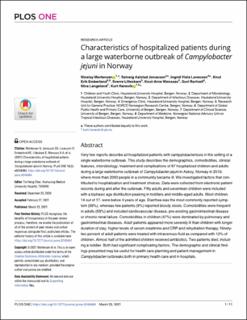| dc.description.abstract | Very few reports describe all hospitalized patients with campylobacteriosis in the setting of a single waterborne outbreak. This study describes the demographics, comorbidities, clinical features, microbiology, treatment and complications of 67 hospitalized children and adults during a large waterborne outbreak of Campylobacter jejuni in Askoy, Norway in 2019, where more than 2000 people in a community became ill. We investigated factors that contributed to hospitalization and treatment choices. Data were collected from electronic patient records during and after the outbreak. Fifty adults and seventeen children were included with a biphasic age distribution peaking in toddlers and middle-aged adults. Most children, 14 out of 17, were below 4 years of age. Diarrhea was the most commonly reported symptom (99%), whereas few patients (9%) reported bloody stools. Comorbidities were frequent in adults (63%) and included cardiovascular disease, pre-existing gastrointestinal disease or chronic renal failure. Comorbidities in children (47%) were dominated by pulmonary and gastrointestinal diseases. Adult patients appeared more severely ill than children with longer duration of stay, higher levels of serum creatinine and CRP and rehydration therapy. Ninety-two percent of adult patients were treated with intravenous fluid as compared with 12% of children. Almost half of the admitted children received antibiotics. Two patients died, including a toddler. Both had significant complicating factors. The demographic and clinical findings presented may be useful for health care planning and patient management in Campylobacter outbreaks both in primary health care and in hospitals. | en_US |

